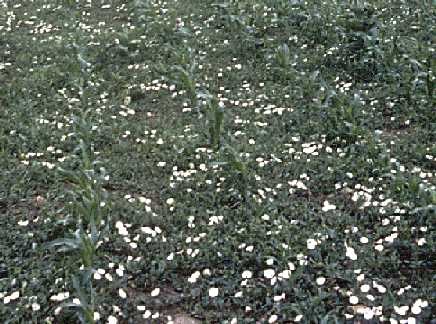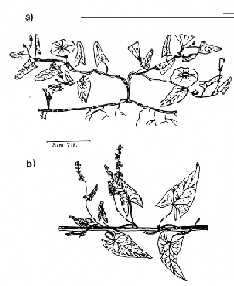Field bindweed
Learn how to identify field bindweed, growth characteristics related to control and control options.
ISSN 1198-712X, Published February 2001
Description
Field bindweed (Convolvulus arvensis L.) is a perennial weed with an extensive root and rhizome system, slender twining or trailing stems which often form dense tangled mats, and white or pink trumpet-shaped flowers (Figure 1). The leaves are alternate on the stem, triangular to arrowhead-shaped with smooth margins, and vary from 2–5 cm in length. Field bindweed is in the morning-glory family and its flowers resemble those of the familiar ornamental morning-glories. They are borne singly or occasionally in pairs in the axils of the leaves, and the flower stalk has 2 small leafy bracts (2–4 mm long) attached mid-way between flower and main stem. Fully-opened flowers are 1.5–2.0 cm long and 2.0–2.5 cm across. The spherical seed capsules contain 1–4 seeds which are 3-angled, with 1 rounded and 2 flattened sides, dull brownish-gray, and coarsely roughened.
Field bindweed is sometimes confused with hedge bindweed and wild buckwheat. Hedge bindweed (Convolvulus sepium L.) is quite similar in appearance and growth habit to field bindweed but its leaves, flowers and seeds are larger, and it has 2 large, leafy bracts (10–20 mm long) which enclose the base of the flower rather than being attached mid-way on the flower stalk. Hedge bindweed is found primarily in pastures, abandoned fields or hedgerows, rather than in cultivated fields, but methods of control are similar to those for field bindweed. Wild buckwheat (Polygonum convolvulus L.) also has arrowhead-shaped leaves and twining stems, but is an annual weed that does not regenerate from the root and is easily controlled by cultivation. It can also be controlled by many of the herbicides used to control broad-leaved weeds. Wild buckwheat can be distinguished from field bindweed by its larger leaves, the thin membrane (ochrea) that encircles the stem at each node, clusters of small green flowers in the leaf axils or at the tips of branches, and dark brown to black triangular seeds with sharp corners. (Figure 2).
Field bindweed was introduced to eastern North America from Europe and Asia in the 18th Century. It rapidly spread westward and is now found throughout the United States and in the agricultural regions of all provinces of Canada, with the exception of Newfoundland and Prince Edward Island. In Ontario, bindweed can be found in all regions with more than 2300 heat units, but is most frequently encountered in the southern counties. It is a particularly troublesome weed in field beans, corn, soybeans and cereals, and can also be a problem in orchards, vineyards and ornamentals. It competes with crops for water, nutrients and light and its twining growth habit interferes with harvesting operations and may result in lodging of the crop.
Growth characteristics related to control
Field bindweed spreads by seeds, roots and rhizomes. It is usually introduced to a new area by seeds that can be spread by birds, water, in manure or as contaminants of commercial seed. The seeds have a hard, impermeable seed coat, and can remain dormant in the soil for 20 years or more.
As soon as bindweed is established in a new area, an infestation can spread locally by roots and rhizomes. After the first growing season, the roots of a single plant may cover an area 3 m in diameter and produce up to 25 daughter plants. Roots of older plants may occupy an area 6 m in diameter and several metres in depth if soil is quite permeable. The roots possess interior buds that can develop into either shoots or roots or remain dormant. These buds exhibit marked seasonality, with activity greatest in the spring and least in late summer. Rhizomes and attached lateral roots can survive if severed from the primary root, and roots that are fragmented by cultivation will regenerate new plants from those portions containing buds. The extensive root network stores a large quantity of carbohydrates which provide the energy for the regrowth of shoots and roots from root buds even several years after continuous removal of top growth. Seedlings and first-year plants are easier to control than older plants but even 3-week-old seedlings are able to regenerate from the root if the top is removed.
Control
Control of field bindweed used to depend primarily upon intensive tillage and crop rotation. Two years of summer fallow with cultivation repeated every 10 days was an accepted practice for bindweed control in grain-growing areas. However, even 2 yrs. of continual defoliation will sometimes fail to completely exhaust the root reserves. Competitive crops such as winter wheat or perennial forages grown over several years will reduce but not eradicate bindweed infestations. Systemic herbicides can provide good control of field bindweed, particularly when combined with crop rotation and timely cultivation.
Precise timing is the key to controlling bindweed with herbicides. To be effective, the herbicide must move throughout the root and rhizome network, killing the root buds as well as the top growth. Movement of herbicides to the root system is greatest at the early flowering to full bloom stage of growth, when root reserves are at their lowest and new sugars produced by the leaves are being moved downward. Earlier or later treatments usually destroy only the leafy top growth without being carried to the roots. Too much herbicide is not effective either. It may kill the top growth too quickly and prevent the herbicide from being moved down to the roots and rhizomes.
Herbicides which provide good control of field bindweed when applied at the proper stage of growth include glyphosate (for example, ROUND-UP, TOUCHDOWN), dicamba (for example, BANVEL), and 2,4-D. Apply at the bud to full bloom stage, which usually occurs in late June or July. Bindweed can also be effectively controlled after wheat harvest by spraying in late August or early September when the plants have resumed vigorous growth and started to flower. Suppression of field bindweed can be achieved by postemergence applications of contact herbicides such as glufosinate ammonium (LIBERTY, IGNITE), bentazon (BASAGRAN), or acifluorfen (BLAZER). Preplant burndown applications and soil applied herbicides generally will not control field bindweed. For information concerning these herbicides, rates of application, crops in which they may be used safely, and specific cautions, consult the latest edition of OMAFRA Publication 75, Guide to Weed Control.
A successful bindweed control program will include:
- the timely application of recommended herbicides at the proper rates;
- rotation to crops in which these herbicides can be safely applied and which will provide competitive pressure; and
- continued vigilance to remove escapes. It is much easier to eradicate bindweed seedlings than older plants which have formed large patches with an extensive interconnected root network.

